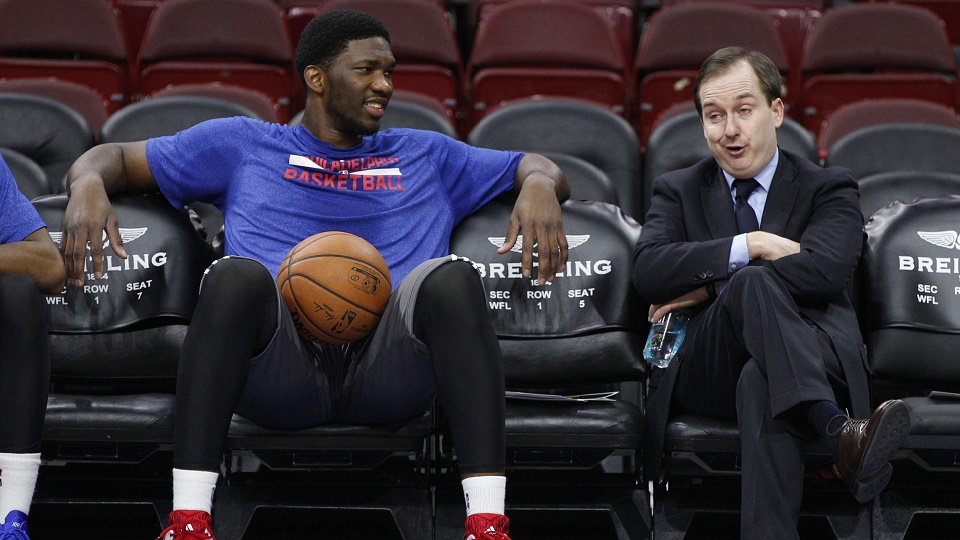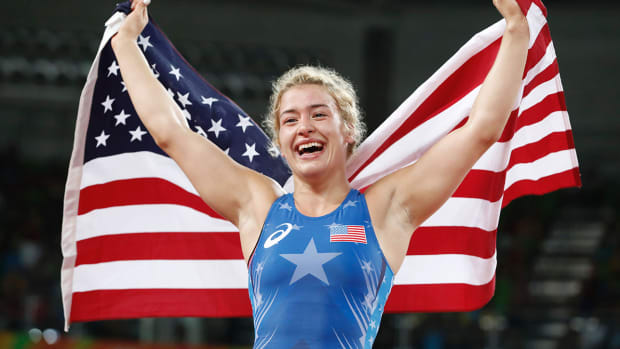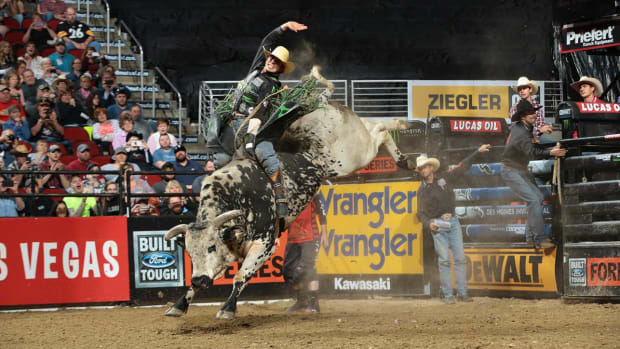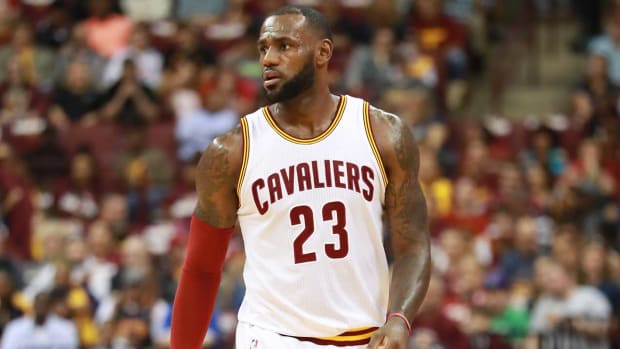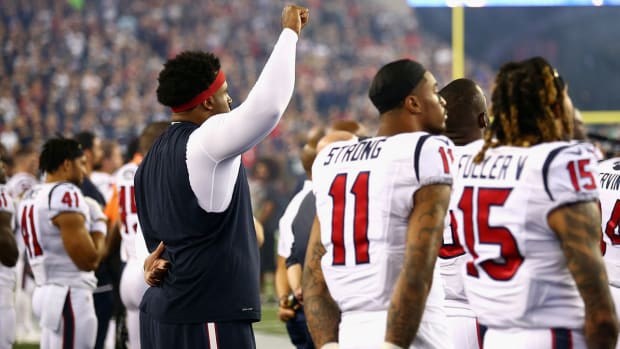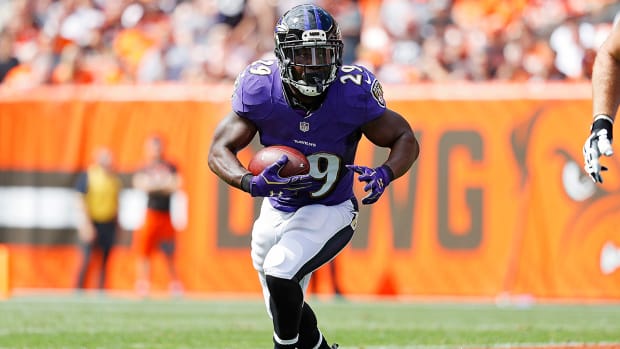Covert dealings, Embiid's attitude are undermining Philadelphia's 'process'
The Philadelphia 76ers are entering the third year of their long-term rebuilding project, one which has largely been characterized by a transparent attempt to be as bad as possible for as long as possible in order to maximize the team’s chances of drafting a generational star. The team’s general manager, Sam Hinkie, has steadfastly displayed tunnel vision regarding the team’s chosen path toward future contention, without apparent regard — at least publicly — for the growing extent of the damage the approach is causing internally.
Hinkie is considered one of the smarter general managers in the league, and multiple league sources told The Cauldron that Hinkie still has Sixers majority owner Josh Harris in his corner. Harris, per a source, has no issue (yet) with Hinkie’s approach, largely because the franchise is worth two to three times what Harris and his group paid for it in 2011, but sources suggest that other pieces of the ownership team are getting less patient. There are also increasing indications of internal friction below the ownership level over Hinkie-led decisions.
The gifts and ghosts of Lamar Odom
According to multiple league sources, last season’s decision to trade point guard Michael Carter-Williams — Hinkie’s pick in his first draft with the franchise in 2013, and a second-year player coming off winning the league’s Rookie of the Year award — was Hinkie’s alone, and the move angered both head coach Brett Brown and CEO Scott O’Neil, who were caught unaware. Although Brown previously had some dustups with Carter-Williams, he had no desire to take a competitive step backward and give up one of the team’s better players for a (potentially valuable) future first-round pick. O’Neil was miffed because he was planning to market the team around Carter-Williams and fellow 2013 lottery pick Nerlens Noel.
Per a league source, Hinkie did not like that Carter-Williams was a poor shooter, and thought that at 23 years old, Carter-Williams was too old to meaningfully improve in that area. That appears to go against the club’s documented pattern of drafting and/or signing long, rangy athletes with the hope that they can improve their shooting. The Sixers track every shot players take during practices to help in that endeavor, so to give up on Carter-Williams so quickly and determine that he was beyond repair calls into question the initial decision to select him at No. 11 overall (even in that season’s decidedly underwhelming draft) when the club had needs up and down its roster, not just at point guard.
The Cauldron reached out to O'Neil for comment. Michael Preston, the team's director of public relations, responded to the inquiry via email, stating "that unsubstantiated rumor is a gross mischaracterization of the events leading into the Michael Carter-Williams trade. Our organization has been and will continue to be opportunistic when deal of that nature become available."
• MORE NBA: 14 NBA players in contract years looking to cash in
The friction may come to a head, though, over Hinkie’s decision to select Kansas center Joel Embiid at No. 3 overall in the 2014 draft. Embiid was considered to have can’t-miss talent and upside, but was red-flagged by multiple teams that season because of back and foot issues that surfaced during and after his only, injured-shortened season as a Jayhawk.
Embiid was selected with the hope that he would follow the same pattern as Noel, who was coming off an ACL tear when he was picked in 2013, and missed his rookie season (which helped the Sixers be bad enough again to land the Embiid pick). Noel was excellent as a rookie in 2014–15, especially as the anchor of a surprisingly decent Philadelphia defense. Hinkie certainly was aware of Embiid’s physical issues when he took a calculated risk to select him, but it’s unclear whether he understood the depth of Embiid’s attitude concerns, which have only worsened as a pro.
The fact that Brown sent Embiid home from a West Coast road trip last season for being insubordinate to the team’s strength coach and training staff is well documented, but according to a source, the tipping point in the decision was Embiid physically threatening the strength coach on that road trip. According to sources, this followed a pattern of insubordination from Embiid during the rehabilitation of his initial foot injury that sidelined him for the entire 2014–15 season, where he would repeatedly refuse to answer questions from the training staff about his workouts and therapy sessions.
Embiid’s lax approach to his rehab and the circumstances surrounding the second foot surgery he needed this past summer — which appears like it will cost him the entire 2015–16 season — has caused the organization much anxiety. The simple task of getting Embiid to consistently wear his walking boot was a challenge for the franchise, and multiple sources suggested that some people in Philadelphia’s front office wonder whether a second surgery would have been necessary if Embiid had worn the boot as much as he was told to.
NBA's growing middle class will force teams to pull off tricky balancing act
Also, according to multiple sources, Harris did not want Embiid to attend the annual Las Vegas Summer League this past July so they could proceed with the surgery on his navicular bone. Brown and Hinkie were both given strict instructions by Harris to keep Embiid from going to Vegas, yet each of them put the onus on the other to handle the job, and neither did.
Embiid was determined to go to Vegas to party for the balance of the 10 days of summer league. While Embiid was in Vegas, he was mandated to wear the walking boot in advance of the second surgery, but Embiid not only refused to wear the boot, but he carried himself as if nothing was wrong with the foot, shooting jumpers and even occasionally dunking. These actions have given rise to the theory that Embiid actually re-broke his foot, rather than the initial injury not healing properly. It also led to Embiid having the surgery a month later than the club originally had hoped.
This type of disregard for instruction also extends to Embiid’s dietary habits. Per a source, the Sixers’ training staff was so concerned about what he was eating, they stocked the refrigerator in his downtown hotel residence each week with healthy food. When a staffer went to restock the fridge each week, most everything was uneaten and unopened, and they were throwing out the fruits and vegetables every week. When the team subsequently asked to see Embiid’s room service bill, they found that most days he was ordering junk food along with his signature beverage, a pitcher of Shirley Temples. Embiid also was frequently seen feasting on chicken fingers and hot dogs at and after games.
• NBA storylines: Western Conference | Eastern Conference |Best benches
Although there’s nothing particularly uncommon about a 21-year-old with poor dietary habits, the pattern of Embiid’s chronic insubordination makes this part and parcel to a larger issue. While reports of Embiid ballooning to 300 pounds were patently false, Embiid’s conditioning and dietary habits are a constant source of strife for the Sixers front office, per multiple sources.
So, this season, the Sixers will roll with a frontcourt of Noel and 2015 No. 3 overall selection Jahlil Okafor, thanks to Embiid’s unavailability as well as that of Dario Saric, the team’s other 2014 lottery pick. Attempts to negotiate a buyout of Saric's European deal this past summer didn't come off, and the Sixers may not see Saric for quite some time yet.
According to a source, Saric’s father, who acts as a de facto representative for his son, doesn’t want the Sixers close to Saric. When Hinkie traveled to Turkey to meet with Saric in the summer of 2014, he was given very little face time with him, at the father’s direction. If Saric waits until the 2017–18 season to come to the NBA, he’ll be able to sign a contract that is not subject to the rookie wage scale (in the same way Chicago Bulls forward Nikola Mirotic did). As much as Hinkie is playing the long game, having to wait three full seasons to get a first-round draft pick signed and on the floor sets back the program.
Hinkie’s draft and trade record also is at odds with the strengths of Brown, who was valued as a player development asset when he was hired, and wants to play the same kind of pace-and-space system that’s prospering in other franchises around the league. In his first season in charge, the Sixers played at the fastest tempo in the NBA; last season, they were seventh. Meanwhile, Hinkie has drafted four big men and a point guard who was subsequently traded, leaving Brown with a roster ill-fitted for that system, and no NBA-caliber starting point guard to work with.
For all of the respect that Brown commands for his demeanor, patience, and Xs and Os acumen, he’s still a coach who has lost 130 games in his first two seasons. His San Antonio pedigree has always been considered a big plus, but maybe not as much as it once was. According to a league source, it’s not lost on Sixers ownership that more coaches off of Gregg Popovich’s coaching tree have struggled than succeeded, and Brown’s standing may not be as firm with the club as most people outside perceive it to be.
The Sixers’ mantra under Hinkie has been “trust the process,” but with the process having led to a still ill-fitting roster, a ton of losses, and a growing sense of distrust within the organization, it’s fair to wonder just how much longer this can all stay together before some very real changes are made.
(Ed. note: The original version of this story stated that Saric did not have a buyout clause for after the 2015-16 season.)
